Kazatin
Vinnitsa Region
Kazatin, 2012
More detail you can read on the Russian-language version of the site, as the English version in the process of finalizing
A Jewish presence is first mentioned in Kazatin in the second half of the 18th century. In the middle of the 19th century only a few Jews lived in the town.
The ensuing development of railway lines in the area led to a dramatic increase in the Jewish population. In 1897 Kazatin's 1,731 Jews comprised 20.1 percent of the total population.
In the early twentieth century Kazatin were two synagogues.
There was a pogrom in Kazatin in 1905.
In 1913, Jews owned Kazatin warehouse of pharmaceutical goods, Photo shop, 12 shops, including all 7 manufactories.
Jews of the town suffered greatly during the revolutionary years and the civil war in Russia. In 1918 Jewish houses were looted during a pogrom in the town.
In the late 1920s and early 1930s Kazatin had a Jewish council that held its deliberations in Yiddish. In the 1920s and part of the 1930s there were Yiddish-language schools in the town.
In 1939 Kazatin had 2,648 Jews, who constituted 15.8 percent of the total population.
The ensuing development of railway lines in the area led to a dramatic increase in the Jewish population. In 1897 Kazatin's 1,731 Jews comprised 20.1 percent of the total population.
In the early twentieth century Kazatin were two synagogues.
There was a pogrom in Kazatin in 1905.
In 1913, Jews owned Kazatin warehouse of pharmaceutical goods, Photo shop, 12 shops, including all 7 manufactories.
Jews of the town suffered greatly during the revolutionary years and the civil war in Russia. In 1918 Jewish houses were looted during a pogrom in the town.
In the late 1920s and early 1930s Kazatin had a Jewish council that held its deliberations in Yiddish. In the 1920s and part of the 1930s there were Yiddish-language schools in the town.
In 1939 Kazatin had 2,648 Jews, who constituted 15.8 percent of the total population.
After the German invasion of the Soviet Union on June 22, 1941, some Kazatin Jews were evacuated eastward or fled on their own to the Soviet interior.
Kazatin was occupied by German troops on July 14, 1941. Several weeks after the start of the occupation all Jews still living in Kazatin were forced into a ghetto, which included several streets of the town. Inmates of the ghetto were strictly forbidden to leave the ghetto and were forced to perform various types of hard labor. The Jews also had to wear a white armband with a Star of David.
In August and September 1941 about a dozen Kazatin Jews were murdered by units of Einsatzgruppe C. In early June 1942 most of Kazatin's Jews were shot near the village of Talimonovka. Several dozen young, able-bodied Jews and skilled Jewish workers who had been temporarily spared were murdered in December 1942 in the same area.
After the war in Kazatin settled Jews who returned from the war and from evacuation. Most of them together with their families went to Israel and other countries in the late twentieth century.
Currently, the city has a small Jewish community.
Kazatin was occupied by German troops on July 14, 1941. Several weeks after the start of the occupation all Jews still living in Kazatin were forced into a ghetto, which included several streets of the town. Inmates of the ghetto were strictly forbidden to leave the ghetto and were forced to perform various types of hard labor. The Jews also had to wear a white armband with a Star of David.
In August and September 1941 about a dozen Kazatin Jews were murdered by units of Einsatzgruppe C. In early June 1942 most of Kazatin's Jews were shot near the village of Talimonovka. Several dozen young, able-bodied Jews and skilled Jewish workers who had been temporarily spared were murdered in December 1942 in the same area.
After the war in Kazatin settled Jews who returned from the war and from evacuation. Most of them together with their families went to Israel and other countries in the late twentieth century.
Currently, the city has a small Jewish community.
 |
 |
 |
 |
| Former synagogue | |||
 |
 |
 |
 |
| Railway station before repair | And so it is now | ||
 |
 |
 |
 |
 |
 |
 |
 |
| Still a little bit of Art Nouveau | Water tower | "Death is worth livin ..." Victor Tsoy, popular Soviet rock singer, died in 1990 |
Photo www.shukach.com

My shtetl
My shtetl
Jewish towns of Ukraine
Jewish towns of Ukraine


